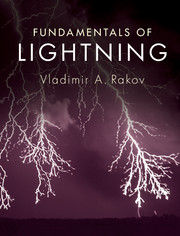Book contents
- Frontmatter
- Dedication
- Contents
- Preface
- 1 Types of lightning discharges and lightning terminology
- 2 Incidence of lightning to areas and structures
- 3 Electrical structure of thunderclouds
- 4 Properties of the downward negative lightning discharge to ground
- 5 Calculation of lightning electromagnetic fields
- 6 Modeling of the lightning return stroke
- 7 Measurement of lightning electric and magnetic fields
- 8 Electromagnetic methods of lightning location
- 9 Lightning damaging effects and protective techniques
- Appendices
- Appendix 1 How is lightning initiated in thunderclouds?
- Appendix 2 Reconstruction of sources from measured electrostatic field changes
- Appendix 3 Derivation of exact equations for computing lightning electric and magnetic fields
- Appendix 4 Compact intracloud discharges (CIDs)
- Appendix 5 Is it true that lightning never strikes the same place twice?
- Appendix 6 Is it possible to use lightning as an energy source?
- Appendix 7 Lightning safety
- Appendix 8 Lightning makes glass
- Appendix 9 Bibliography on triggered lightning experiments and natural lightning observations at Camp Blanding, Florida (1995–2014)
- Glossary
- References
- Index
Appendix 4 - Compact intracloud discharges (CIDs)
from Appendices
Published online by Cambridge University Press: 05 April 2016
- Frontmatter
- Dedication
- Contents
- Preface
- 1 Types of lightning discharges and lightning terminology
- 2 Incidence of lightning to areas and structures
- 3 Electrical structure of thunderclouds
- 4 Properties of the downward negative lightning discharge to ground
- 5 Calculation of lightning electromagnetic fields
- 6 Modeling of the lightning return stroke
- 7 Measurement of lightning electric and magnetic fields
- 8 Electromagnetic methods of lightning location
- 9 Lightning damaging effects and protective techniques
- Appendices
- Appendix 1 How is lightning initiated in thunderclouds?
- Appendix 2 Reconstruction of sources from measured electrostatic field changes
- Appendix 3 Derivation of exact equations for computing lightning electric and magnetic fields
- Appendix 4 Compact intracloud discharges (CIDs)
- Appendix 5 Is it true that lightning never strikes the same place twice?
- Appendix 6 Is it possible to use lightning as an energy source?
- Appendix 7 Lightning safety
- Appendix 8 Lightning makes glass
- Appendix 9 Bibliography on triggered lightning experiments and natural lightning observations at Camp Blanding, Florida (1995–2014)
- Glossary
- References
- Index
Summary
As noted in Chapter 1, there is a special type of lightning that is thought to be the most intense natural producer of HF–VHF (3–300 MHz) radiation on Earth. It is referred to as Compact Intracloud Discharge (CID). CIDs received their name due to their relatively small (hundreds of meters) spatial extent (Smith et al., 1999). They tend to occur at high altitudes (mostly above 10 km), appear to be associated with strong convection (however, even the strongest convection does not always produce CIDs), tend to produce less light than other types of lightning discharges, and produce single VLF–LF electric field pulses (Narrow Bipolar Pulses or NBPs) having typical full widths of 10 to 30 μs and amplitudes of the order of 10 V/m at 100 km, which is higher than for return strokes in cloud-to-ground flashes. As an illustration of their VLF–LF intensity, 48 CIDs examined in detail by Nag et al. (2010) were recorded by four to 22 (11 on average) stations of the US National Lightning Detection Network (NLDN), whose average baseline is 300–350 km. According to Nag et al. (2010), the majority (more than 70 percent) of CIDs appeared to occur in isolation from any other lightning processes. Various electromagnetic signatures of a CID are shown in Fig. A4.1. Perhaps the most puzzling feature of these mysterious lightning events is the fact that their VHF radiation (which is indicative of preliminary breakdown and leader processes creating a new lightning channel), and their wideband signature (which is indicative of a current wave propagating along an already existing channel) appear to be generated at the same time, as seen in Fig. A4.1d where those signatures are superimposed.
As seen in Fig. A4.1, there is evidence of reflections (five secondary peaks labeled S1 to S5) in the wideband electric field and particularly dE/dt signatures, although generally they may be undetectable in measured field waveforms. In Florida, 15 percent of CIDs exhibited oscillations that are indicative of reflections. These reflections, most likely occurring at CID channel ends, influence the magnitude of the overall CID electric field waveform and are responsible for its fine structure, as well as, by inference, for “noisiness” of dE/dt waveforms and for accompanying HF–VHF bursts. On the basis of the experimental evidence of multiple reflections and modeling, Nag and Rakov (2010) inferred that, from the electromagnetic point of view, the CID is essentially a bouncing‐wave phenomenon.
- Type
- Chapter
- Information
- Fundamentals of Lightning , pp. 209 - 211Publisher: Cambridge University PressPrint publication year: 2016



